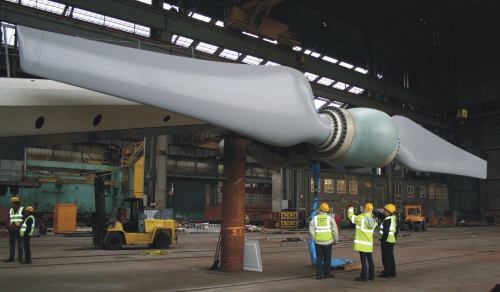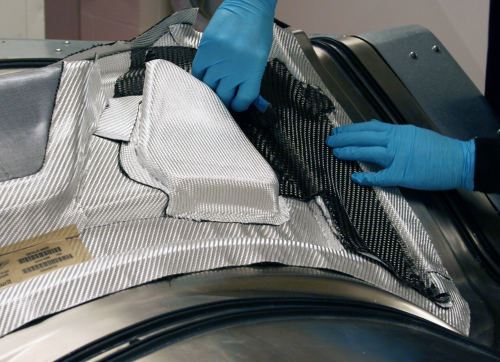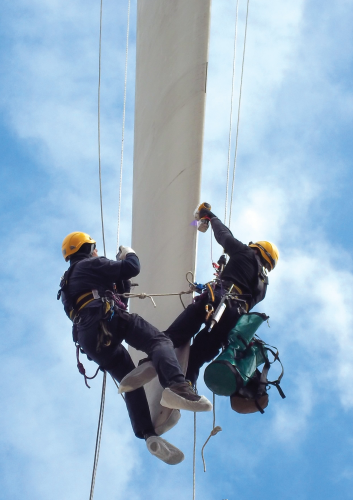


At materials producer Gurit AG, Composites Processing Manager Chris Bunce says that OoA prepregs fit well with the company’s drive to take costs out of composites by addressing materials, processes and storage. The need for low-temperature low-pressure curing, though crucial, is not the only requirement.
“Barriers to wider uptake of OoA prepregs have in the past been limited outlife, handling issues, high cost and the need for temperature-controlled storage,” Bunce explains. “We’ve been breaking these barriers down
| Barriers to wider uptake of OoA prepregs have in the past been limited outlife, handling issues, high cost and the need for temperature-controlled storage. We’ve been breaking these barriers down progressively over the last several years. |
| Chris Bunce, Composites Processing Manager, Gurit AG |
progressively over the last several years. Currently we have a material under test that will have an outlife of some five to six months at room temperature, eliminating the need for refrigerated storage, a major expense with standard prepregs.”
Prepregs for marine and wind energy, end-use sectors in which Gurit has particular strength, easily meet a nominal sub-100°C curing target. For example, SE70 and SE85 materials aimed at marine fabricators are curable at 70°C and 85°C as the designations suggest. An advanced catalyst used in the resin to achieve this adds somewhat to material cost, but vessel builders welcome these prepregs as providing a processing route that is economical overall. Similarly, SparPreg™ materials used by wind turbine manufacturers to produce high quality unidirectional spar caps incorporating glass and carbon fibres, is curable at 80°C.
“A big issue,” Bunce reports “is exotherm. Wind turbine blades in particular have thick laminates in certain areas, and the heat emitted there by epoxies during cure can be a nuisance since control over heating rate may be lost, disrupting the cure cycle. We have worked hard to develop resins that combine reduced-temperature curing with low exotherm. At JEC this year we introduced Velinox™, a modified epoxy resin that cures very rapidly at 100°C. Minimal exotherm in any thickness with this ‘snap cure’ process means that prepregs based on the matrix will tolerate high heating ramp rates, enabling cycle times to be reduced. Intermediate dwells in the cure cycle to control exotherm are not required. Furthermore, such prepregs will not need refrigeration, being storable in temperatures up to 35°C.”
Gurit also has a novel approach to void control. Bunce argues that most voids are inter-laminar, being introduced into the laminate when prepreg layers are brought together. This is commonly addressed by reducing material tack (‘stickiness’) by laying up under cold, tack-reducing, conditions. This, however, requires that fabrication areas are air conditioned, a matter that can prove expensive. As an alternative, Gurit has developed its Airstream™ technology, under which a proprietary surface coating is applied to each prepreg face, reducing its tack and providing pathways via which trapped air can escape during the cure process. The coating becomes absorbed into the lay-up as the cure progresses.
Combining Airstream with SparPreg has resulted in a specialised prepreg which Gurit launched at Wind Power 2012, Atlanta, USA, in June. This allows wind turbine blade manufacturers to produce high quality unidirectional spar caps using high-performance glass and carbon fibres. Securing low void content without the use of cold lay-up or autoclaves, the system provides fast deposition rates without the need for intermediate debulking steps. From Gurit’s point of view, it improves the competitiveness of prepregs against infusion methods in the wind energy sector by enhancing OoA capability.
Another OoA prepreg launched in recent times by Gurit is RENUVO™, a product developed specifically for repairing wind turbine blades and other structures. A specialised resin that can be cured in minutes under a powerful ultra-violet lamp enables technicians to effect repairs in situ.
US-headquartered composites heavyweight Hexcel agrees that OoA prepregs are a promising technology. In a presentation given at the Sandia Wind Turbine Blade Workshop 2012, Dr Chris Shennan, Research & Technology Manager, concluded that cure temperatures down to 70-80°C and reaction isotherms of less than 100 J/g make glass and carbon prepregs highly suitable for wind blade manufacture. This improves the competitive position of prepregs against infusion processes since, given the extreme dimensions of contemporary blades, autoclaving is hardly a practical proposition. Resins now available can achieve reliable and full impregnation, even of carbon, while well-designed material architectures provide minimum voidage. Such prepregs, says Shennan, are suitable even for thick structural sections.
Hexcel points out that OoA prepregs are also becoming accepted in aerospace, the acknowledged citadel of composites quality. Its own HexPly® M56 prepreg, specifically designed for OoA processing, is available with a variety of reinforcements and is usable for both sandwich and monolithic structures. Utilising matrices formulated for vacuum bag only (VBO) cure, materials are available as carbon unidirectional tape, woven carbon or glass fabric and metallic mesh. Matrices provide 30 days tack life at room temperature, along with good drape and tack qualities. Shelf life is 12 months at -18°C.
Fibre volumes are only marginally less than for autoclave equivalents, at more than 50% in all cases. HexPly materials have been evaluated successfully, says the company, in trials of automated fibre placement and automated tape laying (AFP/ATL), provided that the material has been fully impregnated and that provision is made for surface breathing. Automation is likely to be a growing feature of composites manufacture over long production runs, providing consistent quality as well as reduced cycle times and, once the initial investment has been recovered, more economical production.
Airframer impetus
Aerospace is arguably the sector having the highest requirements for laminate quality so here autoclave processing will remain in demand, especially given the high capital investment already made in autoclave infrastructure. However, it is also clear that airframers and their prime suppliers welcome progress towards faster, cheaper composites fabrication and are actively promoting means to achieve it. Both Boeing and Airbus are supporting OoA initiatives. Boeing, for its part, helped fund efforts made during the last decade under the Non-Autoclave (Prepreg) Manufacturing Technology thrust to develop materials that could rival qualified autoclave-cure epoxy materials. Items produced and evaluated included UAV structures based on CYCOM 5320 and an 18 m long all-composite fuselage section for a conceptual Advanced Composite Cargo Aircraft, using Umeco/ACG’s MTM-45 prepreg.
Meanwhile David Inston, Project Leader, Out-of-Autoclave Technologies at Airbus, Bristol, UK, has overseen the production of a primary structure demonstrator and reports that Airbus continues to define its road map for OoA development. Umeco’s MTM44-1 material has been qualified and selected for the A350 XWB wing structures mentioned above.
Tier 1 aerospace suppliers, likewise, view OoA prepregs as a route to the faster, more agile composite fabrication needed for the next generation of commercial jet airliners, which are likely to be 60-70% composite. One such supplier, GKN Aerospace, sees OoA vacuum techniques as enhancing factory efficiency, facilitating a smooth cellular manufacturing work flow undisrupted by queues of large parts awaiting autoclave availability. A promising innovation being pursued by this company is the use of microwave curing. Head of Technology John Cornforth believes that this technique can shorten cure cycle times by up to 80%. Using Umeco/ACG’s MTM prepregs, GKNA is developing microwave processes that leave the tooling and oven chamber cool while heating only the composite, so reducing heating and cooling times and energy usage.
Proceed with caution
Despite the growing maturity and acceptance of OoA prepregs, it is important not to over-hype their promise. For instance, it is easy to overlook the complexity of vacuum bag processing.
As one industry insider put it to us: “It’s not just matter of slapping some bagging material over the lay up, attaching a pump and charging ahead. There are the consumables to think about. As well as the vacuum bagging material and sealing tape you most likely need a release film or agent, a peel ply, a breather fabric and bleeder layer. These all have to be carefully applied and probably renewed for each job. Then there is the time spent in curing and consolidation. It’s normal practice to consolidate the first ply at the tool face separately, and then consolidate every three to five layers after that.”
“Once the job is in the oven [or the tool’s integral heating system is switched on - Ed], the rate at which you can apply heat for the cure depends on how thick the laminate is and how much exotherm you expect. You may need to allow dwell times during each cure cycle so that tool and lamination temperatures can equalise, and afterwards you need to allow for a controlled cooling period. All this adds to cycle time. Close temperature control is important and temperatures need to be monitored at various points with thermocouples.”
Other time-related constraints include the material’s outlife after removal from refrigerated storage (typically -18°C), and the need to warm the material up to room temperature gradually to avoid condensation.
Overall, however, OoA processed prepregs are already making an important contribution to lowering cycle times and costs for composite fabricators, while there is wide agreement that, as the ‘quality gap’ between them and autoclave prepregs continues to shrink, this trend will accelerate. ♦
This feature was published in the September/October 2012 issue of Reinforced Plastics magazine.
The digital edition of Reinforced Plastics is distributed free of charge to readers who meet our qualifying criteria. You can apply to receive your free copy by completing the registration form.






